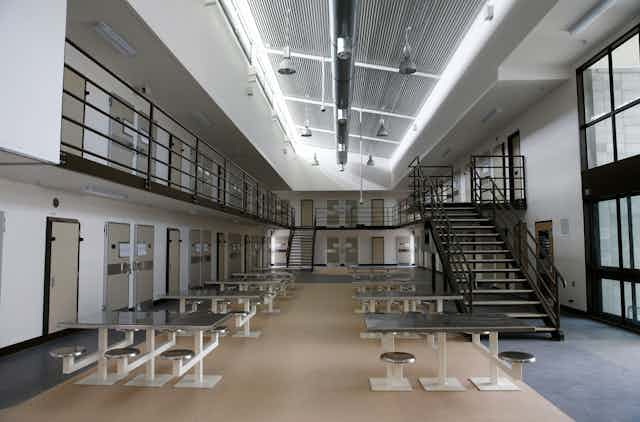The promise to “get tough on youth crime” is a New Zealand election perennial. This year, parties on both the left and right have pledged to crack down on young offenders – despite a lot of evidence that such approaches do not work in the long term.
Already, the Ram Raid Offending and Related Measures Amendment Bill is working through the legislative process. If passed, it would create a new offence within the Crimes Act, allowing the prosecution of children as young as 12, and prison sentences of up to ten years.
Labour, National and ACT all supported its first reading in parliament. Labour in government also announced new high-needs youth justice units, drawing criticism from opposition parties and justice reform advocates.
National is proposing a new “young serious offender” justice category, as well as the creation of “youth offender military academies”. ACT wants 200 new youth justice beds and responsibility for youth justice to move from children’s ministry Oranga Tamariki to the Department of Corrections.
According to current polling, parties on the right may be in a position to form the next government. If so, it seems New Zealand’s youth justice system may take a more punitive turn.

Treating symptoms not causes
The country’s youth justice system established a “new paradigm” in the early 1990s, after the Oranga Tamariki Act 1989 became law. This offered a homegrown approach to families and their young people unique to New Zealand. The model of family empowerment, restorative justice, diversion from court prosecution and reintegration in society became known internationally.
While there was a turn towards more punitive adult criminal justice in Europe and the United States, New Zealand’s system stayed relatively stable until 2008, when a National-led coalition government took power.
Youth justice was a central facet of National’s election campaign to end three terms of Labour-led government. Announcing his party’s “youth plan”, National leader John Key said part of it was about “rolling up our sleeves to prevent New Zealand’s youth crime problem from becoming tomorrow’s crisis”.
This included the now familiar election promise to introduce youth “boot camps”, and to reduce the age of criminal prosecution to 12.
But as critics have long argued, a focus on “crime control” and “risk management” has seen punishment prioritised over addressing the root causes of crime and the best interests of young people.
This can be seen in the disproportionate impact of the criminal justice system on Māori and Pacific youth. According to 2021 data, Māori make up 67% of those in youth detention. Pacific youth account for 7%, and those who identify as both Māori and Pacific account for 13%. Young people who identify as neither Māori nor Pacific comprise only 13% of that population.
Failing to address the complex developmental and social drivers of youth crime means those statistics are unlikely to change.
What is working?
There is also considerable evidence of the influence young people’s gradual cognitive and social development can have on criminal behaviour.
These age-related factors include reduced impulse control, difficulty with future planning, greater risk taking and susceptibility to peer influence. At the same time, age also offers an increased potential for positive change.
Importantly, offending by children and young people is also often related to challenges at home and in communities, including poverty, housing instability, and poor physical or mental health.
Read more: Why rehabilitation – not harsher prison sentences – makes economic sense
Young people with fetal alcohol syndrome spectrum disorder, histories of trauma, brain injuries, and neurodiversity are all criminalised at proportionately higher rates than the general population.
The current evidence supports a less punitive approach to youth offending, through diversion or the use of specialist courts, based on promoting welfare and addressing the underlying causes of offending.
There is evidence in New Zealand that restorative justice reduces reoffending. Family group conferences have been shown to reduce the “frequency and seriousness” of offending for 70% of participants, with Rangatahi Courts also helping reduce reoffending and promote other positive outcomes.
And the police are proposing to broaden the scope of Te Pae Oranga Iwi community panels, which aim to intervene and help with family and personal problems, and have demonstrated a significant reduction in harm from adult (17 years or older) reoffending.
Trust the evidence
While these developments are encouraging, the investigation into “baby uplifts” by Oranga Tamariki, testimonies to the Abuse in Care Royal Commission, and reports of abuse in Oranga Tamariki residences, all raise serious questions about placing more young people in institutions.
Furthermore, New Zealand’s rate of youth offending has been decreasing for some time. But there is a disproportionately high number of youth justice beds here relative to other comparable countries, especially considering the system struggles with mental health support.
The United Nations has already identified the human rights concerns with New Zealand’s low age of criminal responsibility, punitive practices like “spit hoods”, and the disproportionate numbers of rangatahi Māori in the criminal justice system.
Read more: 10 is too young to be in court – NZ should raise the minimum age of criminal responsibility
An evidence-led approach to youth justice would involve Māori and see the expansion of specialist courts throughout the country. Rather than lowering the age of criminal responsibility, the eligible age for appearing in the youth courts would be raised.
Overall, the goal would be to minimise the imprisonment of young people, including remand in police cells and youth or adult detention facilities. And there would be much greater investment in iwi partnerships to provide wrap-around community services that are whanau-focused and culturally appropriate.
As the former chief science adviser to the prime minister reported in 2018, more resources directed at mental health, trauma, substance abuse and inadequate housing should be the basis of preventing more youth offending. A more punitive response may win votes but it will not solve the problem.

